Preface: Parallel with Ahrar al-Sham al-Islamiyya Movement’s announcement of "They Were Wronged"[1] battle’s third stage on January 28, 2018, the Syrian/ Russian alliance escalated its military attacks on a number of Eastern Ghouta cities and towns. Harasta city[2] had the highest share of it, as residential neighbourhoods were shelled by rockets loaded with incendiary substances (similar to napalm) for three consecutive times in late January 2018, specifically on 28, 30 and 31 of the same month, causing injury to a number of civilians, as well as material damage to their property, according to many testimonies obtained by Syrians for Truth and Justice reporter in Eastern Ghouta.
According to STJ reporter, these three attacks, which targeted populated areas with weapons loaded with incendiary substances, were the first of its kind since the beginning of 2018. Syrian regular forces had already used incendiary devices to bomb Harasta city in 2017, according to an earlier report prepared by STJ.
"Hassan al-Ghabees/al-Kabees", a resident of Harasta who were present at the scene of the first attack, assured STJ that more than 15 ground-to-ground missiles landed on the city on January 28, 2018, 10 of which were loaded with incendiary substances (similar to napalm), where he said:
"At 5:00 p.m., I saw the rockets landed on the buildings facing my house, and they had earlier landed directly on a huge population centre and resulted in burn injuries for about 18 civilians, as well as the material damage caused by the shelling, where the napalm burned over 50 houses in our neighbourhood only. While I was helping in putting out fires and rescuing the wounded, the Syrian regime shelled the same area again with ground-to-ground missiles loaded with explosive materials in order to make the fires devour as much space as possible. Fire suppression process lasted more than 12 hours, the more we tried to put it out, the more it flared up elsewhere.
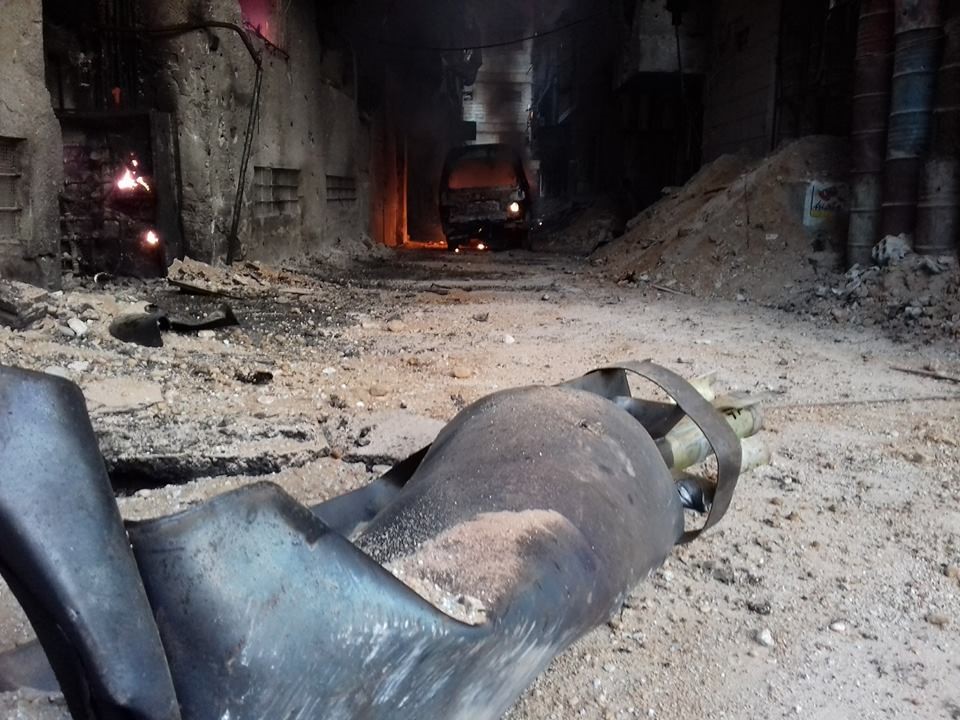
Image shows the remnants of a ground-to-ground missile loaded with incendiary substances, which landed on Harasta on January 30, 2018.
Photo credit: Local Council of Harasta City.
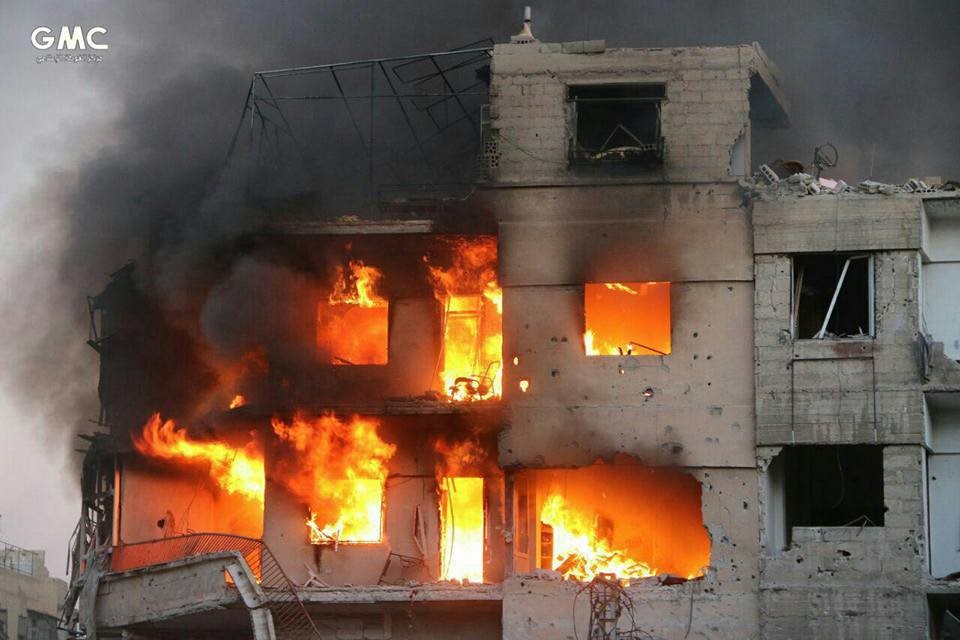
Image shows the fires erupted in one of the residential neighbourhoods in Harasta city, being shelled with incendiary devices (similar to napalm) by Syrian regular forces on January 28, 2018.
Photo credit: Ghouta Media Centre.
Hassan continued that the Syrian regular forces had bombed Harasta with incendiary devices on January 30, 2018, specifically at 6:00 p.m., in order to cause panic and fear among people. In this regard, he added:
"On that day, Harasta was shelled with more than 25 ground-to-ground missiles, six of which were loaded with incendiary substances, burning down more than five buildings, as well as a number of shops and buses, the regime also targeted the region with explosive rockets to hinder the rescue operations and the extinguish of fires. The regime deliberately shelled the residential compound, which is one of the most populated areas in Harasta, noting that there is no military headquarters within these targeted areas. We feel like the earth closed in on us, we don’t know where to go, we are in a state of a constant displacement, and we are no longer able to settle in one place."
In another testimony, "Ahmed Shihab", a resident of Harasta, who was present at the scene of the second attack, indicated that many civilians, who were near the places where the rockets were falling, were subjected to suffocation, headaches and nausea, pointed that the fire was returning to flare up again whenever they put it out.
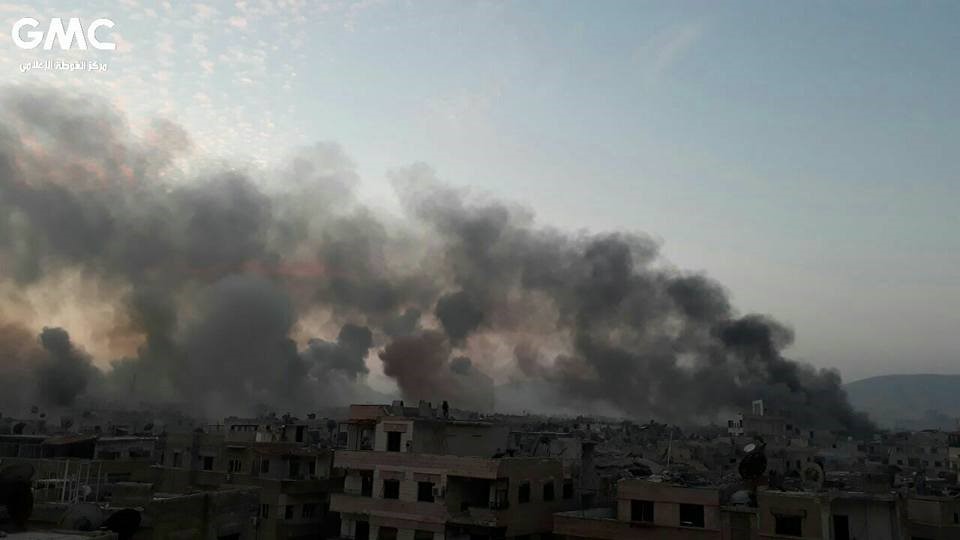
Image shows smoke plumes rising from Harasta city, after being shelled with incendiary devices (similar to napalm) on January 30, 2018. Photo credit: Ghouta Media Centre.
According to STJ reporter, the neighbourhoods of Harasta were, for the third time in a row, shelled with ground-to-ground rockets loaded with incendiary substances on January 31, 2018, causing significant material damage to civilian property, where fires broke out in five houses, with no causalities.
A video footage published by the Civil Defence in Damascus countryside showed a side of the fires broke out in Harasta as a result of the shelling of residential neighbourhoods with incendiary devices on January 28, 2018. Another video footage also published by Civil Defence on January 28, 2018, showed the fall of a ground-to-ground missile on residential neighbourhoods in Harasta city, coinciding with the set of fires caused by incendiary devices bombardment on the same date.
On January 31, 2018, a statement was issued by the operation room of "They Were Wronged" battle, in which it confirmed the targeting of the Harasta city by more than 27 ground-to-ground missiles, six of which are loaded with incendiary substances (similar to napalm). Indicating that some of them landed on detention sites of the Syrian armed opposition factions in the cities, which resulted in the death of 4 Syrian Regular Army fighters were held by the opposition.
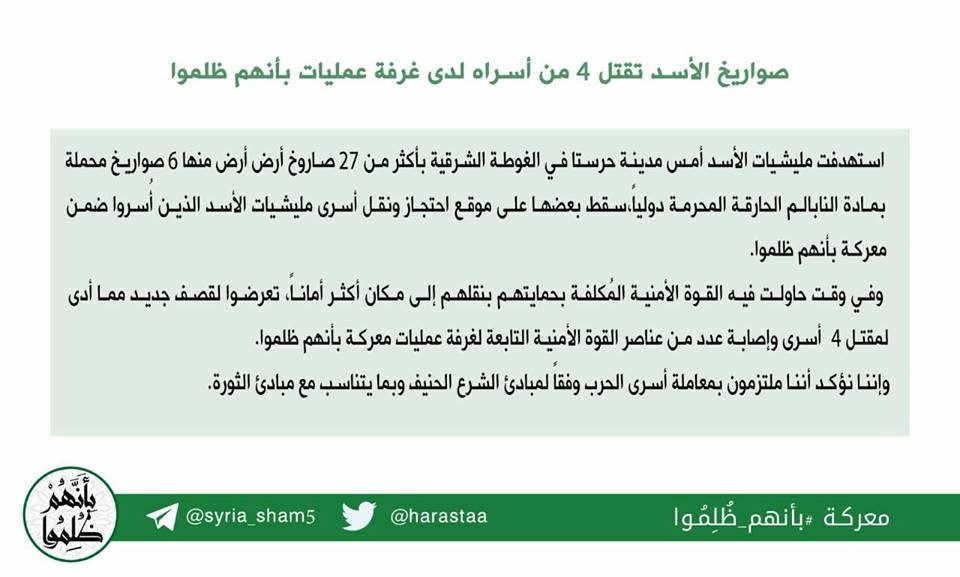
Image shows the statement issued by the operation room of "They Were Wronged" battle on January 31, 2018, in which it confirmed the targeting of Harasta city with rockets loaded with incendiary substances.
Photo credit: Twitter Page of "They Were Wronged" battle.
Ahmed al-Talli, a fighter of the Syrian armed opposition, told STJ that during the recent escalation campaign, Harasta used to be bombed with ground-to-ground missiles or the so-called "elephant" rockets, noting that the Syrian regular forces had modified these rockets, by loading them with incendiary substances, and in this regard, he continued:
The "Elephant" rocket is a "Grad" missile, which has ranges between 20 to 40, the Syrian regime amended it, by removing its explosive warhead and installing another, carrying a large quantity of explosives to increase its destructive capacity, though the increase in the explosive load leads necessarily to double the rocket’s range. The Regime also replaces the explosive load, placed inside the rocket, with incendiary substances, which may be soap or rubber added to gasoline. The amount of incendiary substances the Elephant rocket can be loaded with, is the same of the explosive substances’ its head can carry, thus the initiator’s (fuse) task is to be a spark for the combustion of this incendiary substances, after which the whole rocket burns."
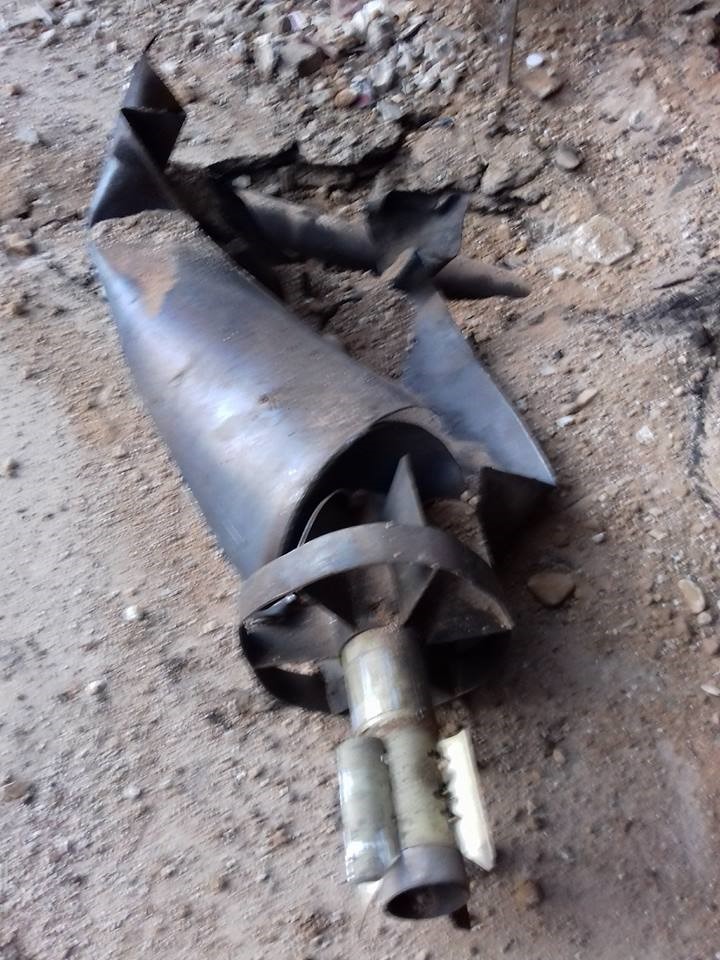
Photo shows the remnants of a rocket loaded with incendiary substances (similar to napalm) had fallen on residential neighbourhoods in Harasta city on January 30, 2018.
Photo credit: The Local Council of Harasta city.
-
Ahrar al-Sham al-Islamiyya Movement announced its three-stage battle "They Were Wronged" in order to control the "Military Vehicles Management", held by the Syrian army, in Harasta. The first stage began on November 14, 2017, in which the fighting resulted in the kill of a number of Syrian regular forces fighters along with the control of Ahrar al-Sham al-Islamiyya Movement on large portions of the Military Vehicles Management base in Harasta. while the second stage began on December 29, 2017, in which the battles led to impose siege on Military Vehicles Management by Ahrar al-Sham al-Islamiyya Movement, in addition to the latter’s control of Al-Ajami neighborhood, the Automated oven, and Al Hadaeq neighborhood, which stretches along the road between Harasta and Irbin from the west side of the Military Vehicles Management. While the third stage began on January 28, 2018, where the Ahrar al-Sham al-Islamiyya Movement blew up a ditch of the regular Syrian forces within the Military Vehicles Management in Harasta city, which resulted in the death and injury of a number of the Syrian regular forces fighters.
[2] Large part of Harasta city is held by Ahrar al-Sham al-Islamiyya Movement (Fajr al-Uma formerly).

